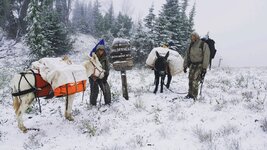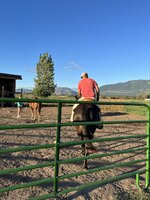Pony Soldier
WKR
I haven't seen a llama in the woods since the early 80s but I certainly see the use.
We probably need to discuss stratagy. When I put in a camp, I usually had a plan for 6-8 individual day hunts from that location. But what if there are no elk in those drainages. I reached a point that my target was 4-6 elk that may be in one of 10-12 drainages.
The new plan was developed by riding and scanning drainage by drainage I could cut tracks or sign. Knowing their usual path I start at the summer range and work my way toward the winter range which may cover 30-40 miles. Each day I may ride up to 20 miles.
When I cut sign, I return the following day and ride within a mile. I tie up my horse in a patch of second growth where she is protected from the weather, hunters, and hopefully predators. The last few years I have had to find areas where there is no dead trees or leaners that could fall on the horse. Then I peal off my riding clothes including chaps and prepare for a chase on foot. I work my way to where they were and pick up the trail. I work my way to where I anticipate they should be bedded. Sometimes that path might take me a few miles. When I was younger 5-7 miles was normal. As I drift past 70, 2-4 and 800ft of elevation seems to be more normal. If I don't connect then I work my way back to my pony and ride out. The plan the next day is to pick up where I left off, in what-ever drainage they are in or working their way towards. Given favorable weather, I usually make contact every 3-4 days. The elk move 4-6 miles a day if they aren't disturbed.
It's a marathon until I get elk on the ground. Once that is occomplished I often spend the rest of the season scouting new ground or going to some place that has deer. This program is not for the casual hunter or the out of shape hunter.
We probably need to discuss stratagy. When I put in a camp, I usually had a plan for 6-8 individual day hunts from that location. But what if there are no elk in those drainages. I reached a point that my target was 4-6 elk that may be in one of 10-12 drainages.
The new plan was developed by riding and scanning drainage by drainage I could cut tracks or sign. Knowing their usual path I start at the summer range and work my way toward the winter range which may cover 30-40 miles. Each day I may ride up to 20 miles.
When I cut sign, I return the following day and ride within a mile. I tie up my horse in a patch of second growth where she is protected from the weather, hunters, and hopefully predators. The last few years I have had to find areas where there is no dead trees or leaners that could fall on the horse. Then I peal off my riding clothes including chaps and prepare for a chase on foot. I work my way to where they were and pick up the trail. I work my way to where I anticipate they should be bedded. Sometimes that path might take me a few miles. When I was younger 5-7 miles was normal. As I drift past 70, 2-4 and 800ft of elevation seems to be more normal. If I don't connect then I work my way back to my pony and ride out. The plan the next day is to pick up where I left off, in what-ever drainage they are in or working their way towards. Given favorable weather, I usually make contact every 3-4 days. The elk move 4-6 miles a day if they aren't disturbed.
It's a marathon until I get elk on the ground. Once that is occomplished I often spend the rest of the season scouting new ground or going to some place that has deer. This program is not for the casual hunter or the out of shape hunter.


